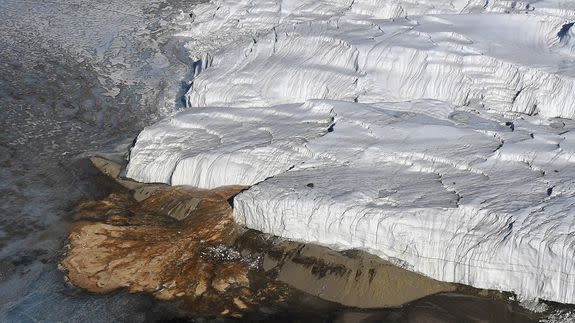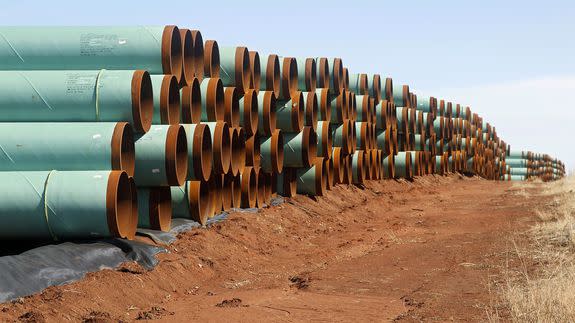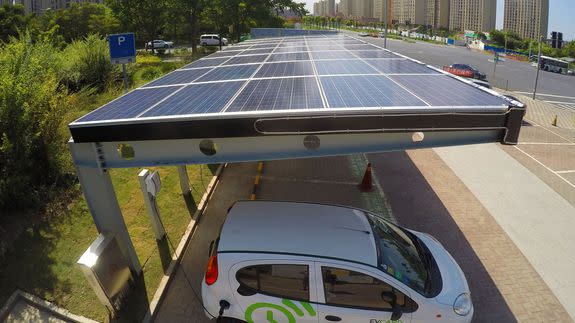China may leave the U.S. behind on climate change due to Trump

President-elect Donald J. Trump will enter office on Jan. 20, 2017 with an agenda that includes dismantling President Barack Obama's environmental actions, particularly when it comes to global warming. Environmentalists are gearing up for a fierce fight against him, and it's easy to see why.
Trump is set to become the world's only leader who does not believe human-caused global warming exists.
In just his first 100 days, he is seeking to green light the Keystone XL Pipeline, a project Obama rejected in 2015, as well as redirect climate aid the U.S. gives to other nations. In doing so, Trump may hand over the mantle of global leadership on combatting climate change to a country he aims to compete more fiercely with: China.
SEE ALSO: Donald Trump will be the only climate-denying world leader
Trump has also pledged to "lift the restrictions" on producing what he says is $50 trillion dollars worth of energy reserves, including shale oil and natural gas as well as, in his campaign's words, "clean coal," which doesn't exist on a commercial scale.

Image: Mosa'ab Elshamy/AP
And that's just what he has planned for the first 100 days. He will have unified control of Congress for longer than that, enabling his administration to undertake even more radical anti-environmental measures should they choose to.
Fragile progress
Obama took more steps to mitigate the effects of climate change than any president in history, having rolled out regulations to curb greenhouse gas emissions from coal-fired power plants, mandated large increases in the fuel efficiency of cars and trucks, and forced regulators to factor in the climate change consequences of federal projects, including some energy projects.
While you might think that Obama's climate moves, which he sees as a cornerstone of his legacy, are durable, Trump may quickly expose their fragility.
The vast majority of Obama's climate agenda has been accomplished using his power as the chief executive, either through executive orders or federal regulations. Such steps can be more easily overturned than bills passed by Congress and signed into law.
Environmental advocates are gearing up for a long and costly fight with a Trump White House over what he will roll back, and the measures he plans to take using his executive authority — such as the authorization of the Keystone XL Pipeline, which Obama rejected in 2015 in part on climate change-related grounds.
"Trump must choose whether he will be a president remembered for putting America and the world back on a path to climate disaster, or for listening to the American public, investing in the fastest-growing sector in the U.S. economy — clean energy — and keeping us on a path of climate progress," said Sierra Club executive director Michael Brune in a statement.

Image: Mark Ralston/AP
"He should choose wisely," he said. "Otherwise, we can guarantee President Trump the hardest fight of his life every step of the way."
Keystone Pipeline
The Keystone XL Pipeline became a flashpoint for climate activists because it would transport oil 1,200 miles from Canada's oil sands region in Alberta through the Central U.S., to the Gulf Coast. There, the oil would be refined and exported to the global oil market.
Trump and other project supporters contend it would create thousands of jobs, although these claims were debunked by multiple studies, including the State Department's own review that showed few permanent jobs would result.

Image: Sue Ogrocki/AP
In rejecting the pipeline, Obama cited the climate impacts of accessing and burning more oil, which at the time was a groundbreaking — and precedent setting, move.
The company seeking to build the pipeline, TransCanada, made it clear this week that it is preparing to apply for approval again under Trump.
The pipeline requires State Department review since it crosses an international border. However, in 2015, Congress passed a bill giving Keystone the go-ahead, but Obama vetoed it. Were a Republican Congress to pass a similar bill, Trump could sign it and fast-track the pipeline instead of going through a new round of State Department reviews.
Studies published in the past two years have shown that if the world is to limit global warming to 2 degrees Celsius, or 3.6 degrees Fahrenheit, or lower compared to preindustrial levels, oil from Canada's oil sands region in Alberta would have to remain in the ground rather than being burned.
Climate advocates at the environmental group Friends of the Earth told Mashable that if Trump were to approve the pipeline now it would be a setback for the "Keep It in the Ground movement," which has gained steam since then and aims to prevent new fossil fuel extraction projects, period.
Soon there will be nothing, other than activist pressure and possibly the courts, standing between Trump and Keystone's approval.
"If he is successful this would be an important symbol of rolling back President Obama’s legacy on climate change," said Kate Colwell, a spokeswoman for the environmental group, in an email.
Clean Power Plan
The Clean Power Plan is a set of EPA regulations that would limit greenhouse gas emissions from coal-fired power plants. The regulations are currently facing court challenges, and have not yet fully entered into force.
The plan seeks to reduce greenhouse gas emissions from power plants to 32 percent below 2005 levels by 2020.

Image: PA Wire/PA Images
Power plants account for roughly one-third of all domestic greenhouse gas emissions in the United States, and the vast majority of the electricity sector's greenhouse gas emissions, according to the Energy Information Administration.
Dismantling the Clean Power Plan, as the Trump campaign vowed to do, would be a complex undertaking. Some states that have already moved forward with implementing the regulations would resist such a move, since it could be costly to scrap the regulations.
However, coal-producing states and those that rely most heavily on coal-fired power plants, such as Ohio, may welcome a regulatory retreat. If the plan is gutted, the U.S. would no longer be on track to meet its commitments under the Paris Climate Agreement.
Climate Finance
A big part of U.S. leadership on climate change is the country's commitment to helping vulnerable nations around the world adapt to climate change impacts, such as heat waves and rising sea levels, and develop technologies to expand their access to energy in a cleaner way.
So-called "climate finance" has been a flashpoint of international climate talks for many years, with developed nations now committed to spending at least $100 billion per year by 2020 in such funding.
Trump has declared that he would cancel U.S. funding, which amounts to about $3 billion annually, for U.N. climate programs and redirect it to domestic infrastructure development.
"Money for developing countries to tackle a climate crisis not of their making – that money is probably gone now," Colwell said.
China as the world's climate leader?

Image: Zhong yang /imaginechina
While it will take time — possibly the entire Trump presidency — to roll back many Obama's climate achievements, make no mistake: It will become much harder for the world to meet its climate goals with Trump in the White House.
This fact could have ramifications lasting decades or more as the planet responds to increased greenhouse gases in the air.
However, there is reason to be optimistic: global energy trends are moving in favor of renewables over coal and other fossil fuels. The worldwide push toward solving global warming that occurred during Obama's presidency has gained enough momentum that it is not going to stop even if the U.S. turns into a rogue state on this issue.
"A shift to a low carbon economy,” says Mark Watts, the executive director of the C40 Cities Climate Leadership Group, “is too well-embedded in large parts of the world, particularly China, for it to be overturned.”
China, in fact, reiterated on Friday that with or without the U.S., it is firmly committed to continuing to reduce its emissions.
"Our policies and action will not be impacted by any action by the U.S. government," Chen Zhihua, of China's National Development and Reform Commission, said at the latest round of UN climate talks in Morocco on Monday.
The question for Trump, then, may be who he wants to lead the world on this issue: the U.S., or China?
